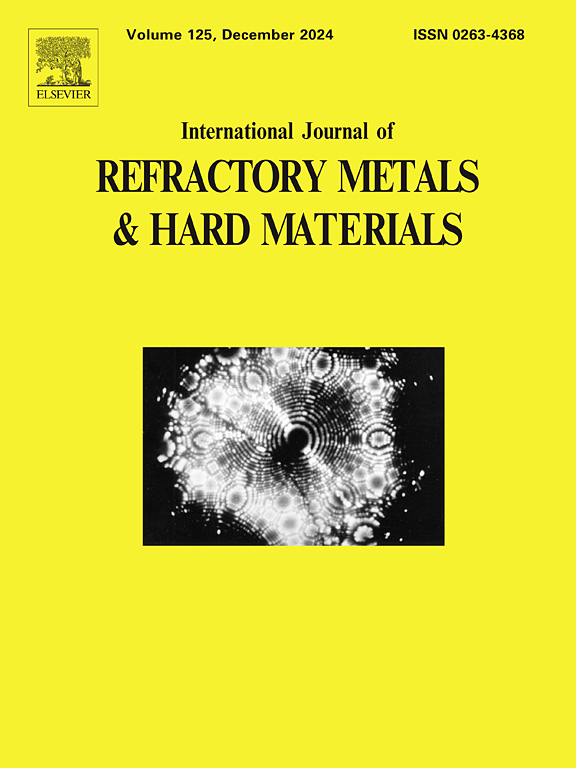Understanding the processability, microstructure, and mechanical properties of molybdenum processed by electron beam powder bed fusion
IF 4.2
2区 材料科学
Q2 MATERIALS SCIENCE, MULTIDISCIPLINARY
International Journal of Refractory Metals & Hard Materials
Pub Date : 2025-02-11
DOI:10.1016/j.ijrmhm.2025.107091
引用次数: 0
Abstract
This work aims to develop and characterize molybdenum (Mo) processed by Electron Beam Powder Bed Fusion (EB-PBF). Two Mo powders with different oxygen levels were used to investigate the processability, obtaining crack-free bulk samples. The process parameter optimization resulted in a residual porosity of around 0.15 %, showing that limiting the oxygen played a key role in reducing the formation of pores. The as-fabricated Mo samples displayed columnar grains with lengths of several millimeters along the building direction composed of numerous subgrain structures created by the thermal stresses of the EB-PBF process. Moreover, the high preheating temperature, as well as the remelting combined with high residual stresses, triggered the formation of a few recrystallized grains. The Mo samples were characterized by a strong 〈001〉 crystallographic fiber orientation along the building direction. The microstructure also revealed the formation of a limited quantity of molybdenum oxides along the grain boundaries. Finally, the bending strength, hardness, Young modulus, and coefficient of thermal expansion (CTE) were determined. The Mo processed by EB-PBF presented bending strength superior to the traditional recrystallized Mo, while the Young modulus and CTE were compatible with the traditional processed Mo.
了解电子束粉末床熔合钼的可加工性、显微组织和力学性能
本工作旨在开发和表征电子束粉末床熔合(EB-PBF)处理的钼(Mo)。采用两种不同氧含量的Mo粉末对其可加工性进行了研究,得到了无裂纹的大块样品。工艺参数优化后,残余孔隙率约为0.15%,表明限制氧气对减少孔隙形成起着关键作用。制备的Mo样品沿构建方向显示出长度为几毫米的柱状晶粒,这些柱状晶粒由EB-PBF工艺的热应力产生的许多亚晶粒结构组成。高预热温度和高残余应力的重熔导致少量再结晶晶粒的形成。Mo样品沿建筑方向具有强的< 001 >的晶体纤维取向。显微组织还显示沿晶界形成了数量有限的钼氧化物。最后测定了材料的抗弯强度、硬度、杨氏模量和热膨胀系数。经EB-PBF处理的Mo的抗弯强度优于传统的再结晶Mo,杨氏模量和CTE与传统处理的Mo相适应。
本文章由计算机程序翻译,如有差异,请以英文原文为准。
求助全文
约1分钟内获得全文
求助全文
来源期刊
CiteScore
7.00
自引率
13.90%
发文量
236
审稿时长
35 days
期刊介绍:
The International Journal of Refractory Metals and Hard Materials (IJRMHM) publishes original research articles concerned with all aspects of refractory metals and hard materials. Refractory metals are defined as metals with melting points higher than 1800 °C. These are tungsten, molybdenum, chromium, tantalum, niobium, hafnium, and rhenium, as well as many compounds and alloys based thereupon. Hard materials that are included in the scope of this journal are defined as materials with hardness values higher than 1000 kg/mm2, primarily intended for applications as manufacturing tools or wear resistant components in mechanical systems. Thus they encompass carbides, nitrides and borides of metals, and related compounds. A special focus of this journal is put on the family of hardmetals, which is also known as cemented tungsten carbide, and cermets which are based on titanium carbide and carbonitrides with or without a metal binder. Ceramics and superhard materials including diamond and cubic boron nitride may also be accepted provided the subject material is presented as hard materials as defined above.

 求助内容:
求助内容: 应助结果提醒方式:
应助结果提醒方式:


